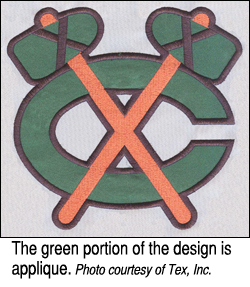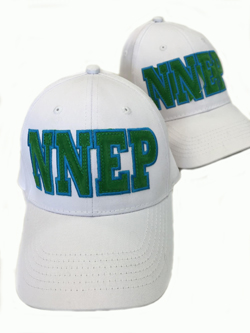Mastering the art of selling appliqued designs is a great way to distinguish yourself from your competition. Many promotional products distributors and sales people do not know what an applique is, much less how to sell it as an apparel decoration option. Step up your game by becoming comfortable talking about and selling appliqued designs to open new sales opportunities with your existing customers and to potentially attract new customers.
Yes, applique is more expensive to create, and therefore to sell, but that translates into higher profit points for you when you work with a qualified contract apparel decoration professional that is skilled in creating excellent applique designs. Let’s break it down so that you are comfortable in a conversation about applique, making it easier for you to sell and for you to hire someone to create it for your customers.
What is applique?
According to Dictionary.com, applique (a noun) is ornamentation, as a cutout design, that is sewn on to or otherwise applied to a piece of material.
 Designs generated using applique are created when a fabric different than the garment is incorporated into the design, literally sewn right on to the garment during the apparel decoration process. The applique fabric is usually put in the design early in the embroidery process and then the rest of the design is sewn over the fabric, creating the details and binding the edges of the added fabric in the process. In the case of “distressed” appliques, the fabric will actually be tattered or shredded and all the edges may not be bound by the design, creating the “urban” look that has been very popular with brands like Aeropostale.
Designs generated using applique are created when a fabric different than the garment is incorporated into the design, literally sewn right on to the garment during the apparel decoration process. The applique fabric is usually put in the design early in the embroidery process and then the rest of the design is sewn over the fabric, creating the details and binding the edges of the added fabric in the process. In the case of “distressed” appliques, the fabric will actually be tattered or shredded and all the edges may not be bound by the design, creating the “urban” look that has been very popular with brands like Aeropostale.
Any kind of fabric can be incorporated into a design – there are endless options. There are certainly better and worse options within the available fabrics, however, depending on the design complexity, the target price point and the overall desired effect for the finished product. The fabric selected should complement the overall design, in tone, texture and style. Adding a applique made out of lace, for example, would look unusual on the back of a varsity jacket! The letters on the back of a varsity jacket that are a different color than the jacket are a common example of applique. These letters are often called "tackle twill" letters, as that is a type of fabric from which the applique is made.
Tackle twill fabrics come in all the common school and athletic colors and can be cut into letters, numbers, the shapes of school mascots – all the typical designs that would be added to varsity jackets or spirit wear. Tackle twill comes with an adhesive applied to the reverse side of the fabric. Once the embroidery design is completed, the apparel decoration professional presses the garment and binds the applique fabric to the garment, which helps the design look crisp longer.
 Your customer can even provide a fabric if they have their heart set on a particular look. While not ideal, this can be managed successfully depending on the resources available to your apparel decoration professional. If the order involves many garments, they will need to cut the fabric to fit the design. If they have to send the fabric out to have it cut, that will add time and cost to the job.
Your customer can even provide a fabric if they have their heart set on a particular look. While not ideal, this can be managed successfully depending on the resources available to your apparel decoration professional. If the order involves many garments, they will need to cut the fabric to fit the design. If they have to send the fabric out to have it cut, that will add time and cost to the job.
There are several ways to cut the fabric to incorporate it into the design. For orders of only a few pieces, embroiderers can cut the applique fabric by hand. For orders of any quantity, it becomes much more efficient to cut the fabric with the assistance of some sort of equipment, such as a cutter, laser or even a custom die for large orders. There are even fabrics that are engineered specifically for applique, as they perforate cleanly once the embroidery design is completed.
Many logos can be modified to incorporate applique. In fact, your customers might get excited about having a more “modern” version of their logo to add to their selection of branded apparel. Appliques generally work best for larger designs. It is not usually practical to incorporate only small bits of fabric efficiently, for example in left chest design placements of most headwear designs. Recommend this apparel decoration technique for center front or back designs on sweats, fleece, outwear products where you have room for a good sized design that will create impact. Some oversized chest designs work well with applique, but it depends on the design as to whether it is a good idea or not. The more simple the design, the better it may be on an oversized chest placement.
To convert a design into an applique, the embroidery file does need to be digitized specifically for applique. The sewing sequence is different than it is for the regular design, the stitch count will be different and the cost to create the applique version of the design will be different.
Contact your embroidery professional to inquire if they do applique and to get an estimate for the order so that the prices that you quote to your customer are on target. If the decorator does not sound enthusiastic about doing applique, find another decorator! There are many embroidery professionals that do excellent applique work so there is no reason to put your decorator on the spot if this is not a contract service they offer. Ask to see examples of their applique work if you are not sure about their skills in this technique. If they have several examples and they look good, you should be in good shape. If they cannot come up with any examples to show you, that may be a good indication of how little applique work they actually do.
Adding appliqued designs to your mix of available decoration techniques gives you a reason to contact all of your customers, offering them a contemporary look for their branded apparel. While you will be asking your customers to spend more for the finished garments and for more digitizing fees, you will be offering them a great new look to incorporate into their branded apparel selection while positioning yourself as a valuable brand builder on their behalf.
Jennifer Cox is president of the National Network of Embroidery Professionals. NNEP members receive personalized marketing consulting designed specifically for their business. To join NNEP today, visit NNEP.net, email Jennifer at hooper@nnep.net, or call 800-866-7396.